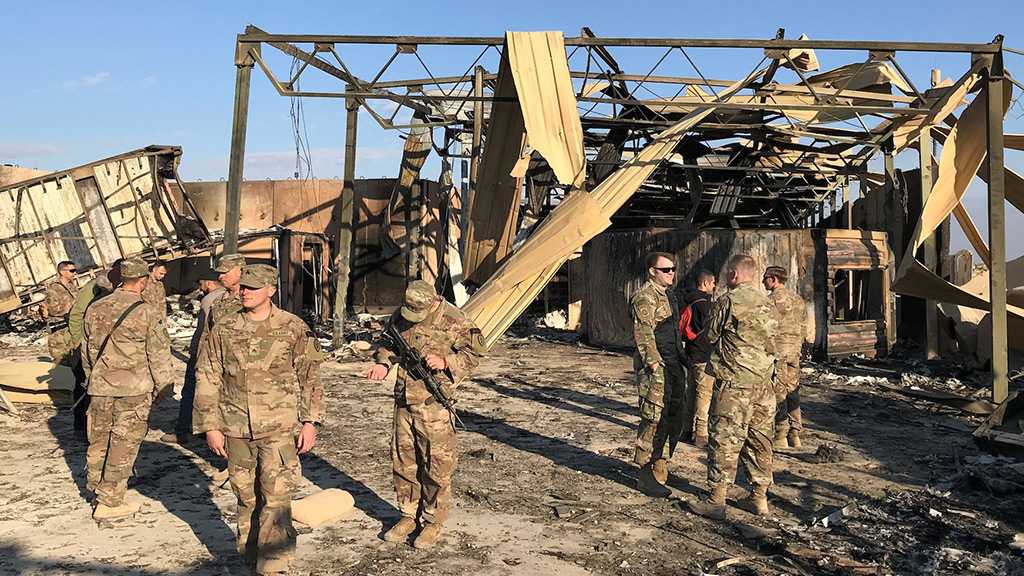Thursday, 23 January 2020
FP: More US Troops Treated for Concussion Symptoms as Trump Downplays ‘Headaches’
By Staff, https://www.english.alahednews.com.lb/51362/393FP
A top US general confirmed that additional service members are being treated for concussion-like symptoms after Iran’s missile strike on a military base in Iraq earlier this month, even as US President Donald Trump downplayed the injuries as “headaches.”
Trump on Wednesday seemed to brush off injuries sustained by US troops after Iran’s Jan. 8 attack, saying at a news conference in Davos, Switzerland, that he did not consider them to be “very serious.”
“I heard that they had headaches. And a couple of other things,” Trump said. “But I would say, and I can report it is not very serious.”
Trump’s comments immediately drew fire from veterans advocates, who noted that traumatic brain injuries [TBIs] are often considered to be the signature wounds of the Iraq and Afghanistan wars due to blasts from roadside bombs and other incidents. Between 2000 and early 2019, the Defense and Veterans Brain Injury Center reported more than 408,000 TBIs among US service members worldwide, according to the Department of Veterans Affairs.
Paul Rieckhoff, the founder of Iraq and Afghanistan Veterans of America, tweeted: “The @DeptVetAffairs and hundreds of thousands of post-9/11 veterans disagree … Don’t just be outraged by #PresidentMayhem’s latest asinine comments. Take action to help vets facing TBIs.”
The news that at least a dozen service members stationed in Iraq are being evaluated for possible traumatic brain injuries emerges two weeks after the attack, prompting speculation that the White House directed a cover-up. Washington and Tehran have ratcheted down tensions after Trump said in the hours after the attack, which came as retaliation for the US assassinating Iran’s Maj. Gen. Qassem Suleimani, that no US troops were killed or injured.
Maj. Gen. Alex Grynkewich, the deputy commander of the coalition to allegedly defeat the Daesh [Arabic acronym for “ISIS” / “ISIL”] terrorist group, said Wednesday that the number of service members being treated for possible TBIs is now “in the teens”—up from 11 who the US War Department acknowledged last week had been transported out of the country to Landstuhl, Germany, and Kuwait for further evaluation. The facility in Iraq does not have MRI equipment.
Grynkewich denied that the White House or any other outside party directed the military to delay talking about the injuries, saying that “TBIs are very difficult to assess” and that commanders were not immediately aware that service members were showing such symptoms.
“In the wake of an attack you are looking for people with cuts and bruises, those sorts of things,” Grynkewich said. After conducting “follow-on assessments,” commanders decided “out of an abundance of caution” to apply concussion protocol, he said.
“Really it just takes some time for the commanders on the ground to get through their assessment period and then some time for that to percolate to us,” Grynkewich said.
The general’s comments echo those made by a Pentagon spokesperson last week. Alyssa Farah, the Pentagon press secretary, told reporters Jan. 17 that following the attack, a number of service members were given “routine examinations” for concussions. The vast majority needed no follow-on exams, but some continued to display concussion-like symptoms days after the attack and reported them to their commanders, she said.
Pentagon leadership was only notified of the 11 initial service members who were transported out of the country for evaluation the day prior—Jan. 16—and “made it public within hours,” Farah said.
“We fully expect these service members to return to their duty when deemed medically able,” Farah said.
Unlike incidents threatening “life, limb, or eyesight,” TBIs don’t normally rise to the threshold for immediate reporting up to the Pentagon, said chief Pentagon spokesperson Jonathan Hoffman. He added that the injured service members got onto transport aircraft “under their own power” rather than being rolled out on stretchers.
Hoffman also downplayed speculation that the White House directed the military to cover up the injuries after the president’s initial comments.
“Every administration official that’s gone on the record on what the intentions of the Iranians were is—including the vice president, the secretary and the chairman—is that their intention was to injure or kill Americans,” Hoffman said. “So this idea that there was an effort to de-emphasize injuries for some sort of amorphous political agenda doesn’t hold water to what the administration has said on the record.”
The views expressed in this article are the sole responsibility of the author and do not necessarily reflect those of the Blog!
Subscribe to:
Post Comments (Atom)















No comments:
Post a Comment